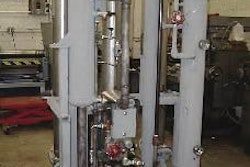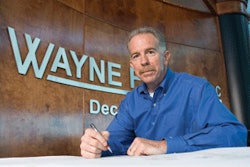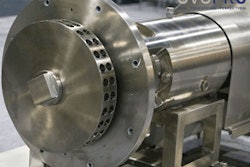.jpg?auto=format%2Ccompress&q=70&w=400)
Energy efficiency has brought an award this year for one of the largest poultry processing plants in Thailand. Not only has the design of the plant saved on energy, according to the citation, it has also achieved a highly significant reduction in the amount of water required by its operations.
The 2008 Technology Award from the American Society of Heating, Refrigeration and Air Conditioning Engineers (ASHRAE) went to the Chokchai, Nakohn Ratchasima, factory of Charoen Pokphand Foods. Details provided by CP Group headquarters in Bangkok refer to the recognition being for first place in the new industrial facilities or processes category of the awards scheme, with a special emphasis on the plant's extra-efficient cooling system.
Known locally as CPF Korat, the facility can handle about 360,000 broilers daily. Both the primary processing and the further-processing segments are inside a single building at the site. They were opened in 2004, as part of an integrated complex to produce poultry products specifically for export. The integration also includes feed production, breeder operation, hatchery and grow-out. Its feed mill is considered one of the largest in Asia, having the capability of manufacturing 1.2 million tonnes of broiler and breeder feeds per year. About 2 million day-old chicks per year come from the Korat hatchery.
All rearing sheds for broilers are computer-controlled for climate and feed, with video camera surveillance so that a single operator can take care of housing for 150,000 birds. They also have evaporative cooling. A similar system for temperature reduction is present in the reception zone for broilers when they go to be processed.
In total size, the processing plant covers about four hectares, with the building itself having a surface area of 50,000m2. It works two shifts daily from Monday to Saturday each week. After slaughter and automated evisceration and giblet harvesting, the chickens are air-chilled in a tunnel sequence that lasts three hours and cools each carcass to below 4 C. Bar coding and computerisation aid in traceability. Inside the cold store, there is a mobile rack arrangement to facilitate transfers and increase the product storage space.
The transfer to further processing within the same building is controlled carefully for temperature. It takes carcasses to a whole-bird processing line that has further-processing channels where deboning, cutting and portioning can occur. The range of products leaving the factory for export runs from chilled/frozen to steamed, roasted and fried.
Focus on refrigeration
Korat's award from ASHRAE has pinpointed particularly the refrigeration system used. The designers of this system had been set the goals originally of ensuring it was energy-efficient and would have a smaller environmental impact, as well as the obvious practical concerns relating to worker safety and the need to minimise downtimes. An additional design goal was to achieve an effective installation at a lower investment cost.
In response, special design concepts were created to produce a sustainable and energy-saving means of refrigeration in each part of the processing plant including its spiral freezers and machine room. The sheer size of the challenge could be seen by the fact that the complex was due to have 46 ammonia-fuelled screw compressors representing a total of 18,000 horsepower, in addition to 21 sets of evaporative condensers in stainless steel that would stretch 200 kilometres if laid end to end. Then there were two tunnel lines for air-chilling 21,000 birds per hour, even before mentioning the six IQF spiral freezers that gave a total freezing capacity of 12 tonnes per hour.
The list was completed by adding a processing area of 6,000 square metres in which the room temperature would have to be kept at 8 C and some 49,000m3 of cold store volume requiring a constant minus 20 C.
Imagine all this in a part of the world where the outside temperature is regularly at the 37 C mark and the relative humidity stays around 60 percent. Another concern was that the local area in Thailand has a high level of chalk in the water supply and there were few practicable water-softening options available, so the designers anticipated some difficulty in removing heat through a condenser network as they feared this might impact the oil temperature in the screw compressors.
They chose an oil cooling arrangement known as Special Liquid Injected Oil Cooling (SOC) as the best solution to overcome the hot/humid climate and the water supply issue. Regardless of how high the condensing pressure goes, they commented, the oil temperature stays within the controlled range. Long-time experience also had shown that the compressor's main bearing could last 7-10 years with SOC, compared to 3-5 years on other oil cooling systems.
Long-distance line
Their next problem was to work out how to avoid a drop in pressure within a two-phase flow wet return line that was scheduled to be installed between the spiral freezers and the machine room, given that this involved a distance of almost 230 metres. Their answer has been to eliminate the long return line, by installing a pump package underneath the freezer and changing the wet return to a pure vapour line with dry suction connecting pump and compressors. Moreover, glycol is used as the secondary refrigerant for low-temperature air conditioning.
A calculation at building time showed that, due to the replacement of the wet return with a dry vapour suction line, about US$200,000 could be trimmed off the set-up cost, as it was possible to use smaller compressors and a smaller suction pipe with less insulation. Some US$115,300 per year could be saved due to reduced water usage from having a clean-in-place (CIP) arrangement based on recirculated hot water together with a top-feed system. Conventional CIP and bottom feed would have needed almost 40.9 million litres of water annually, said the designers, whereas top-feed reduced the volume to some 3.5 million litres.
Estimated annual energy savings of nearly US$258,000 have been gained by a combination of refrigeration and cooling systems giving a reduction of approximately 3,000 MW-hour per year in the power requirement for the plant. Among the contributing factors was a lower power consumption by the evaporative condensers installed, reckoned to save over 1.3 million kilowatt-hours per year. A low internal static air pressure version of spiral freezer allowed the plant to save another 413,100 KW-hour/year compared with conventional freezing.
Other factors lowering the envi-ronmental impact have been use of less ammonia as a refrigerant and a lower Dissolved Oxygen (DO) rating for wastewater treatment.
















